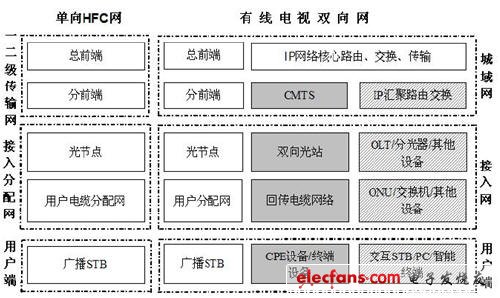The two-way transformation of the broadcast and television network refers to the transformation of the existing one-way transmission and downlink broadcast cable TV network into a two-way transmission and uplink and downlink interactive network. As shown in the figure, the cable TV two-way network is a two-way transmission system that provides users with integrated services by establishing a two-way metropolitan area network and access network. Partly composed. After the bidirectional transformation, the unidirectional broadcast and television services continue to maintain the original HFC logical link, and the bidirectional service routing and logical layering are related to the network bidirectional transformation technology used.

The picture shows: the logical structure diagram of one-way HFC network and cable TV two-way network
1. Overview of the two-way transformation technology plan of the radio and television network
At the engineering level, the two-way transformation of the radio and television network mainly includes the transformation of the optical transmission network and the transformation of the user access network.
1. Access network optical transmission transformation technology
Optical network transmission technology is usually divided into two categories: active optical network (AON) and passive optical network (PON). Active optical network has the characteristics of long transmission distance, power supply, and maintenance. Active optical network is generally based on point-to-point network topology, such as HFC optical network, LAN optical network, etc. Active optical network is mainly used in Trunk transmission network and metropolitan area network.
Passive optical networks are generally based on point-to-multipoint transmission methods, mostly using tree or star (multi-level star) topologies, and are multi-user shared systems. The passive optical network has the characteristics of simple topological structure, low equipment cost, and elimination of active equipment between the office end and the user end. Since the network topology of the PON technology is similar to the topology structure of the cable TV network, the passive optical network technology has become a technology applied in the radio and television network.
2. User access transformation technology
There are many types of user access technologies for two-way transformation of the cable TV network, which can be basically divided into HFC network user access technologies, Ethernet protocol-based user access technologies, and other user access technologies. The common characteristics of these types of user access technologies are: broadcast TV services can be transmitted through coaxial cables, and two-way data services can be implemented using IP protocols, all supporting TV broadcast, broadband Internet access, voice services, video on demand, online games and other services .
100 Watt Led High Bay Light is Factory Warehouse Industrial Lighting.High Bay Lamp is a New 'UFO Style' design,Smaller in volume and weight, longer lasting and more efficient the new design is more compact without sacrificing performance. and the 100W High Bay Lamp saves electricity bill and replace the old Metal Halide, HID or CFL bulbs with the new Ufo High Bay Led light.
100 Watt Led High Bay Light
High Bay Lamp,100 Watt Led High Bay Lights,100W Led High Bay Lights,100W High Bay Lamp
Shenzhen Bbier Lighting Co., Ltd , https://www.chinabbier.com